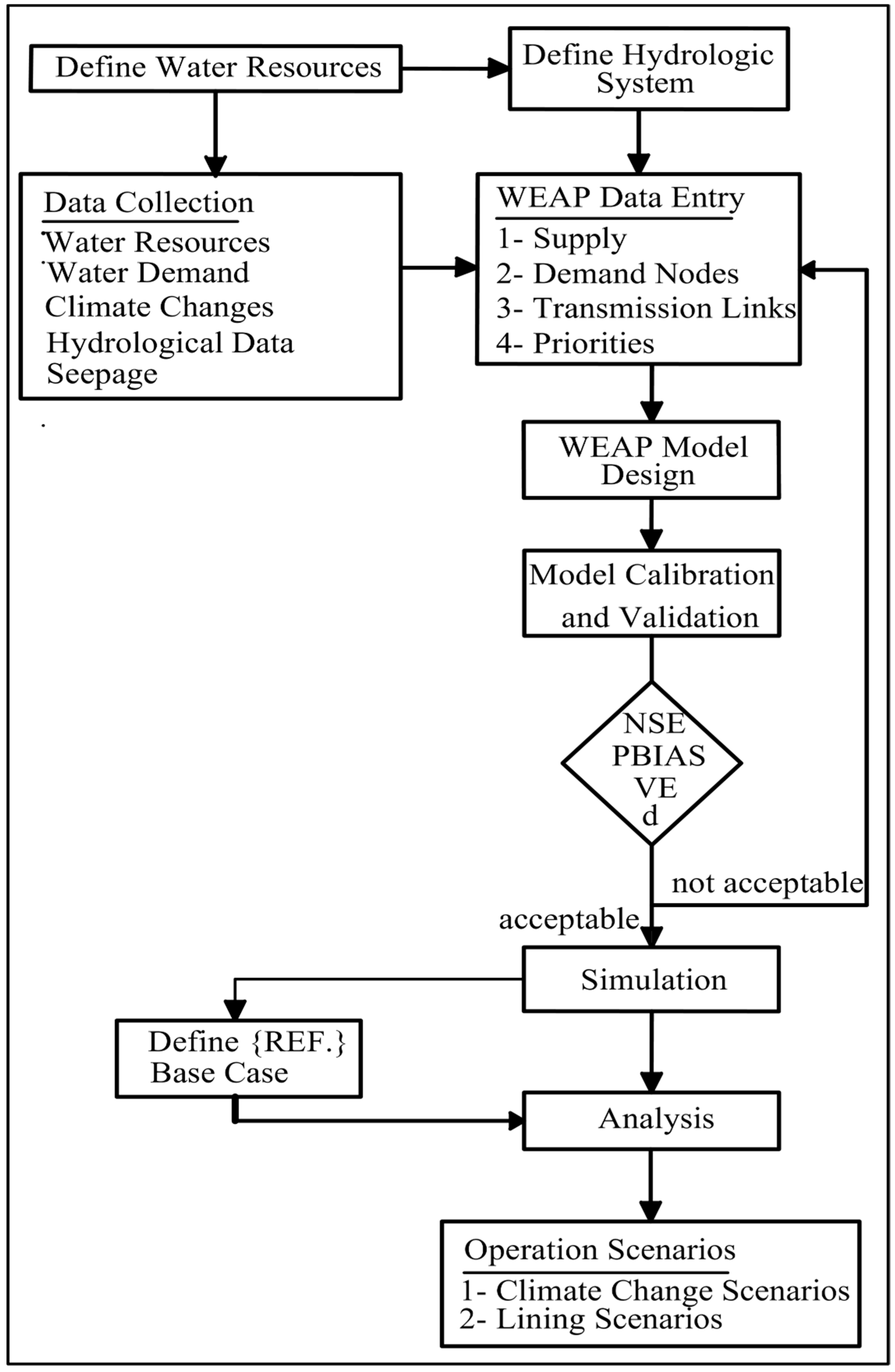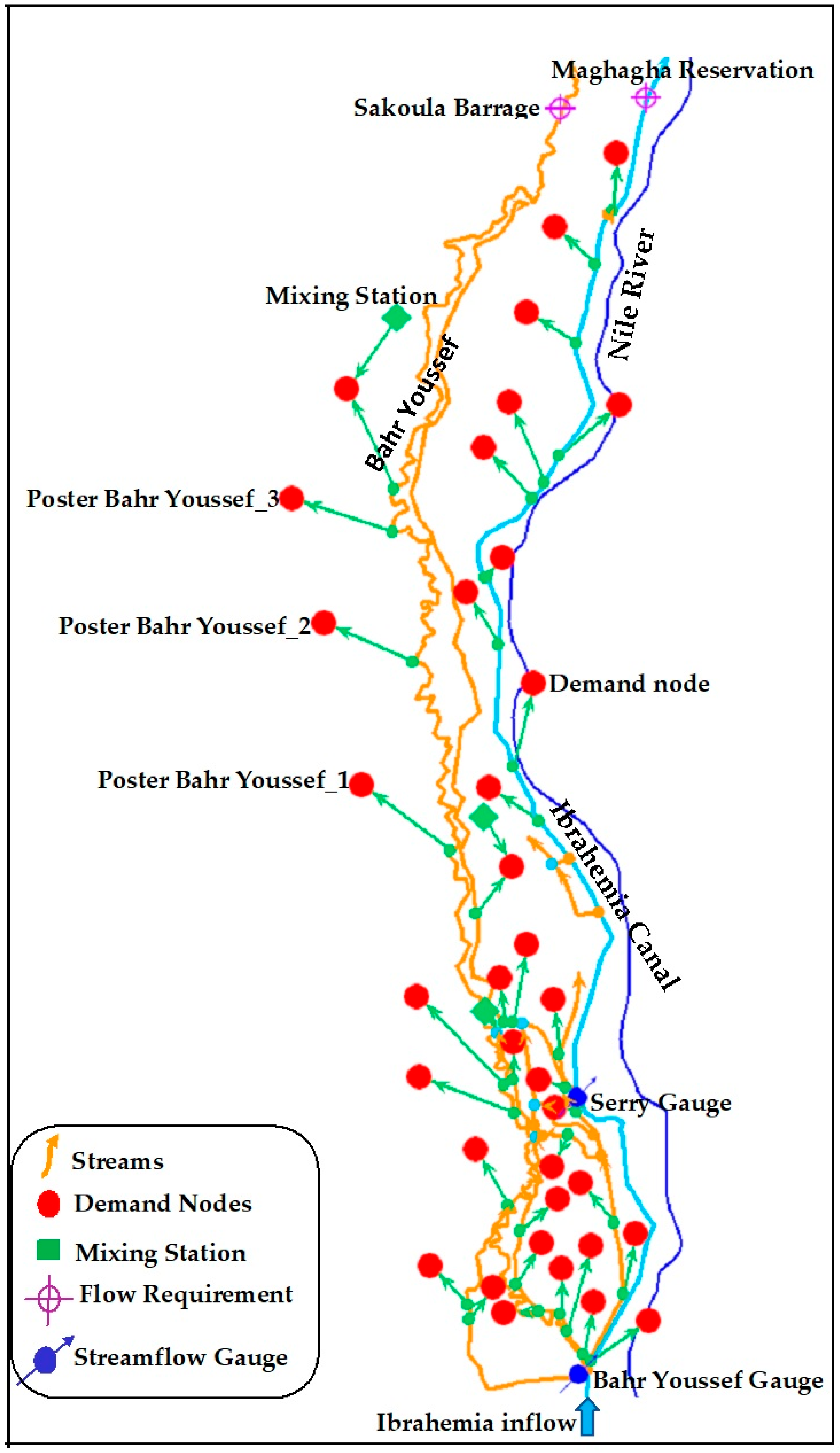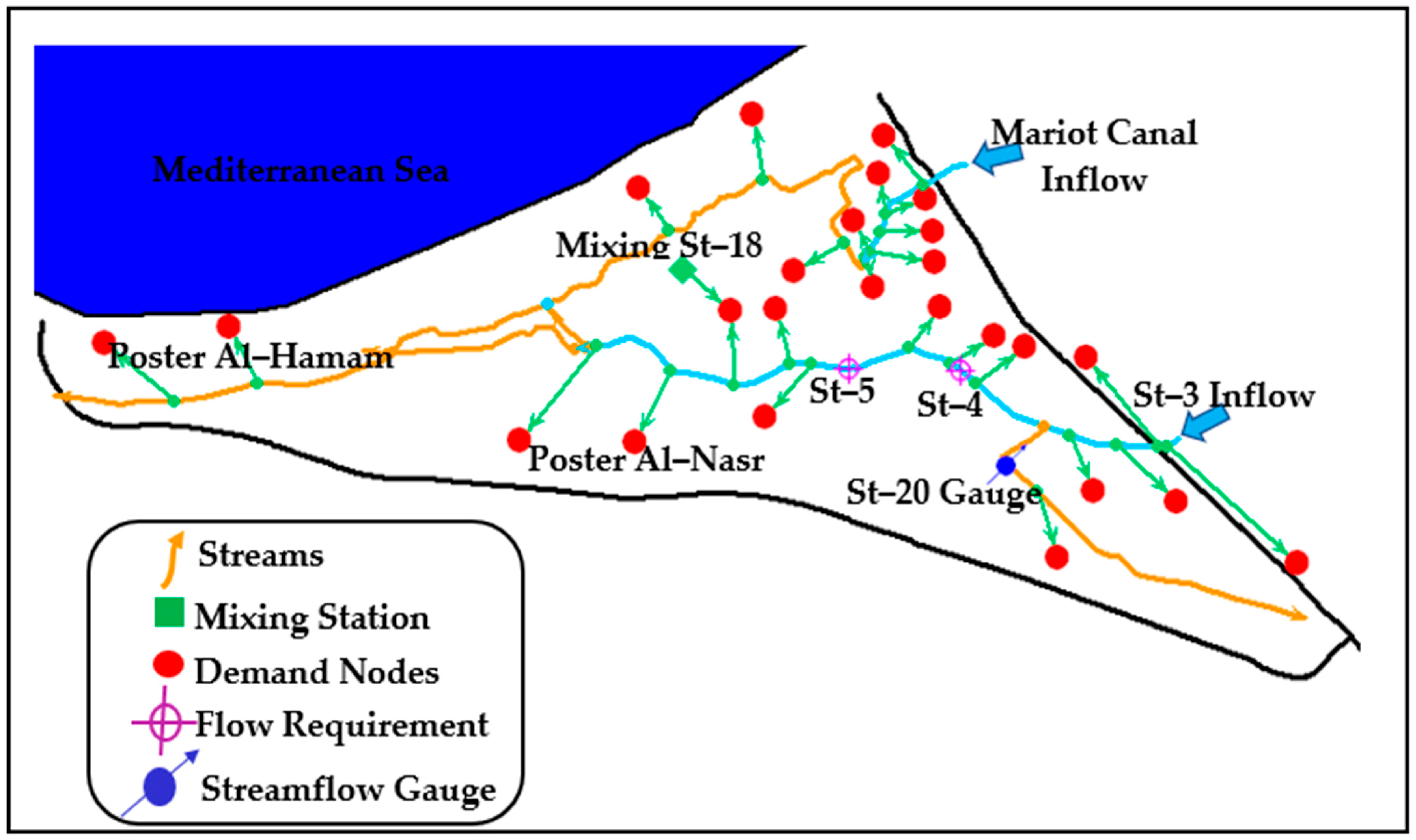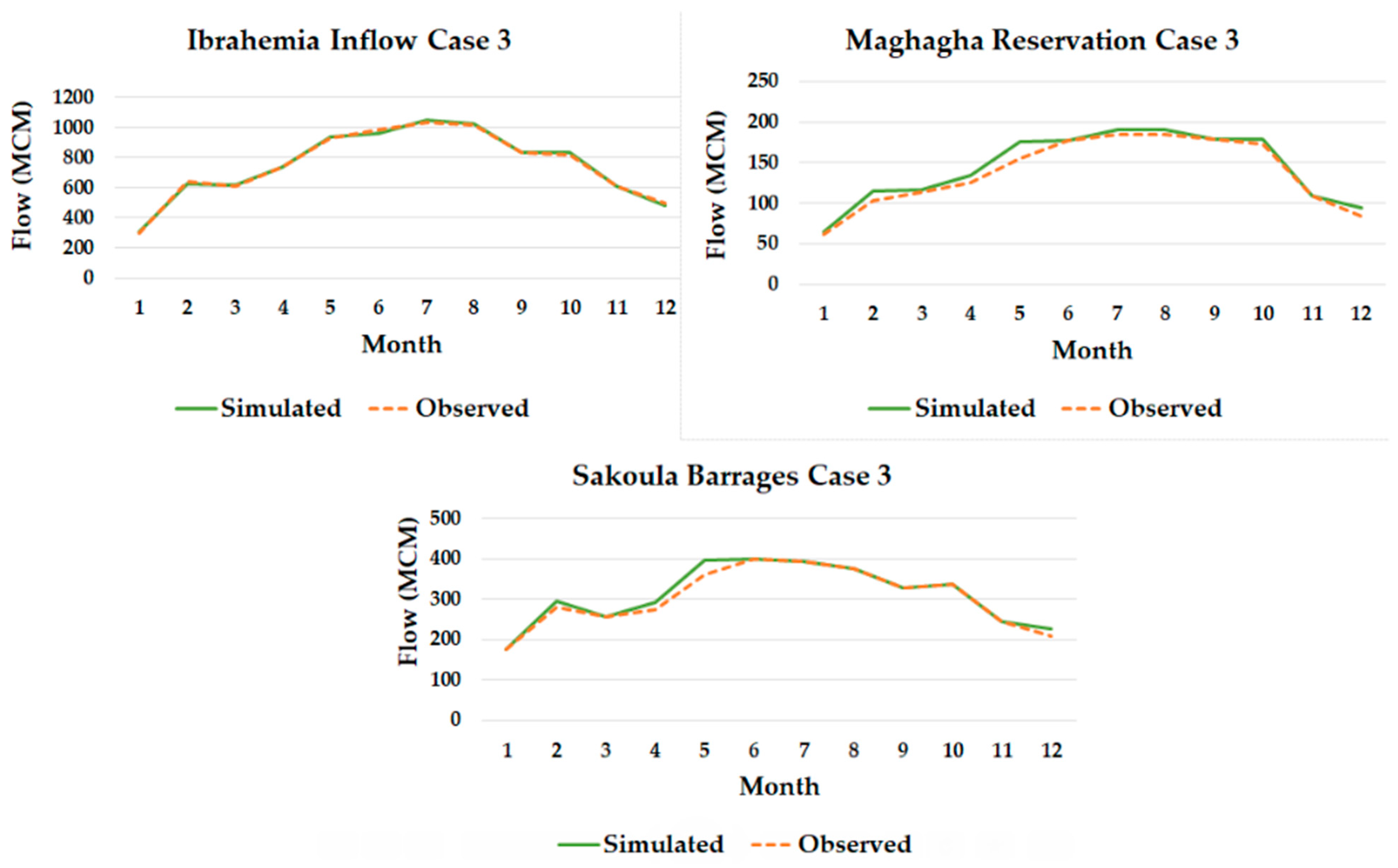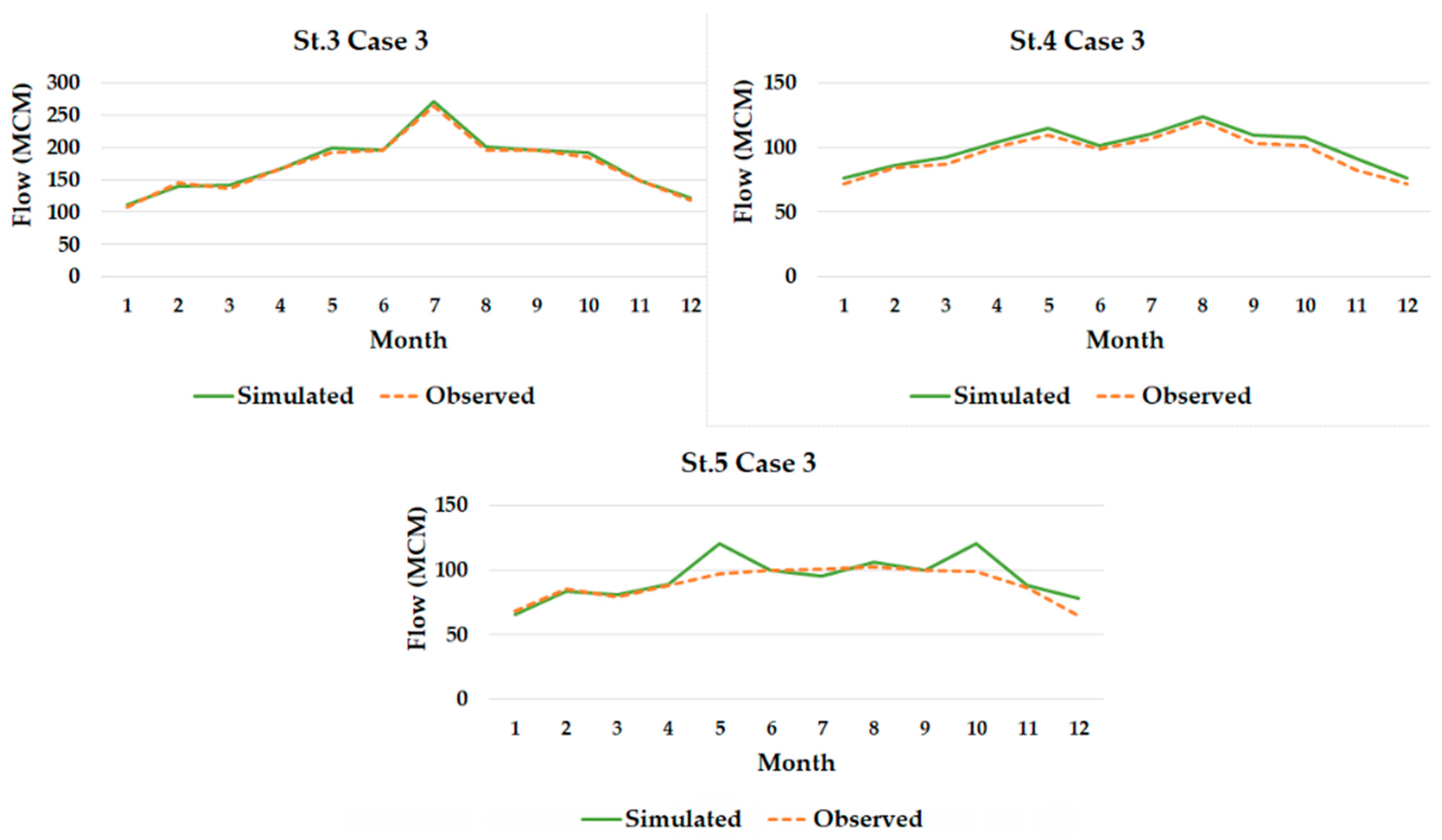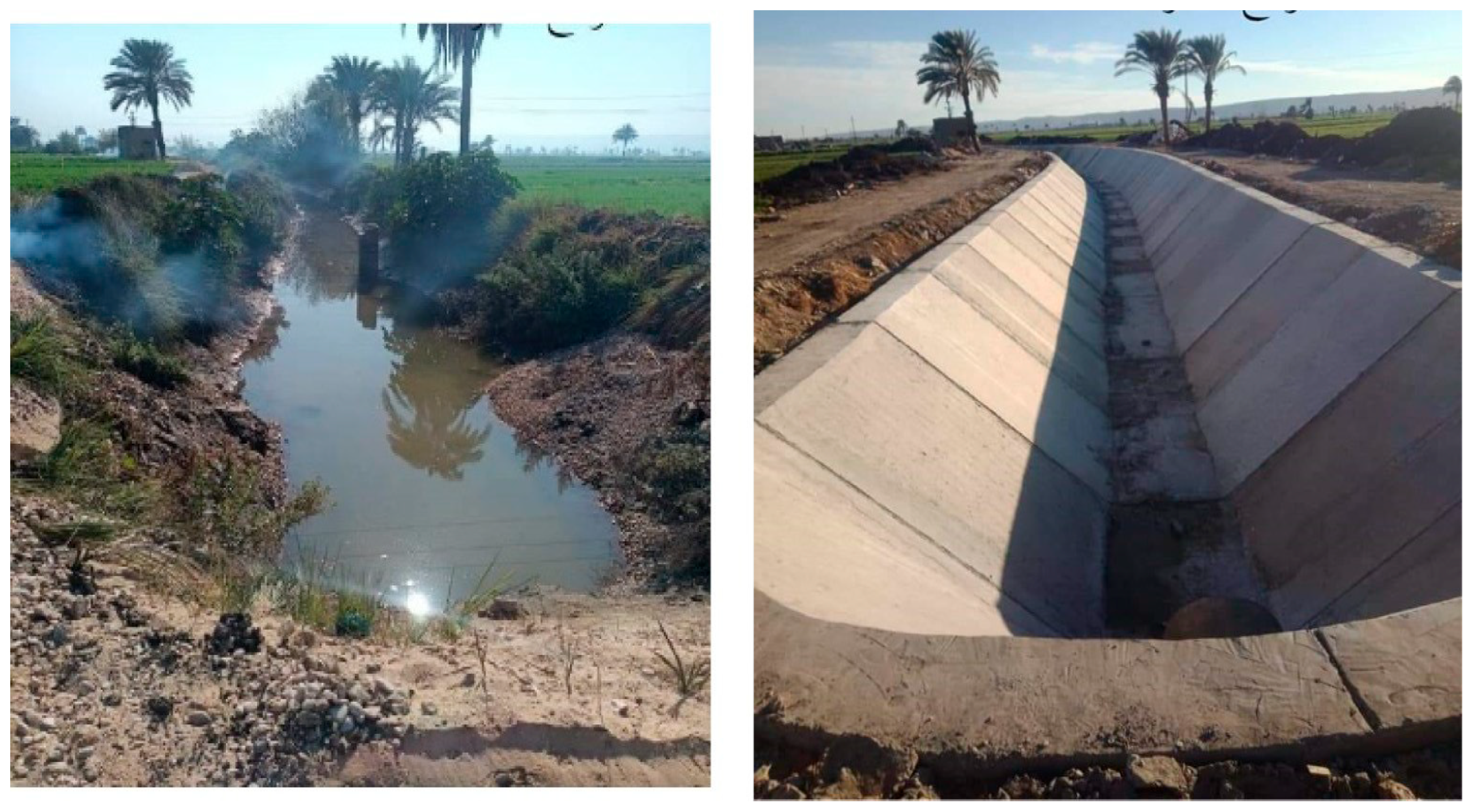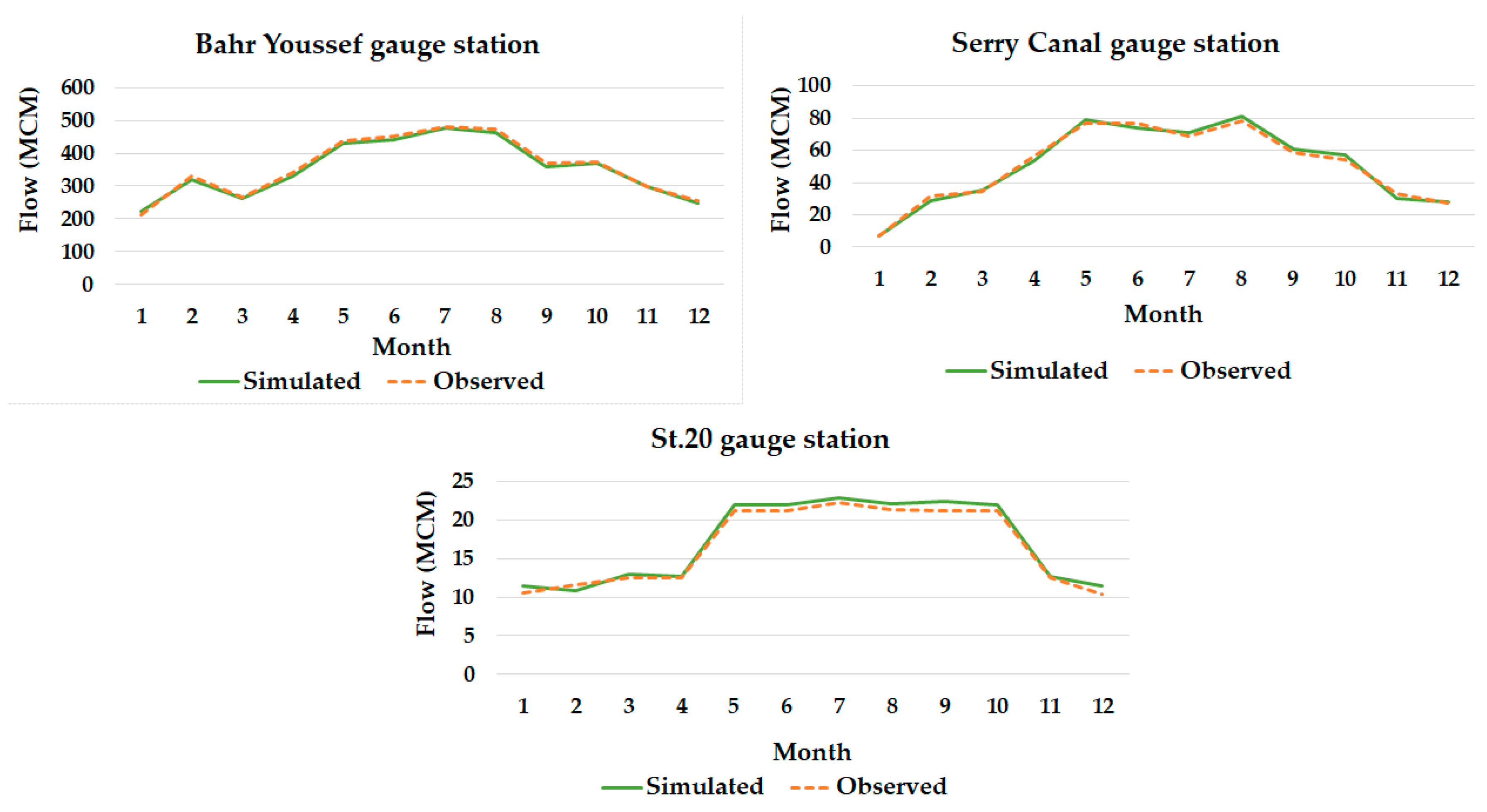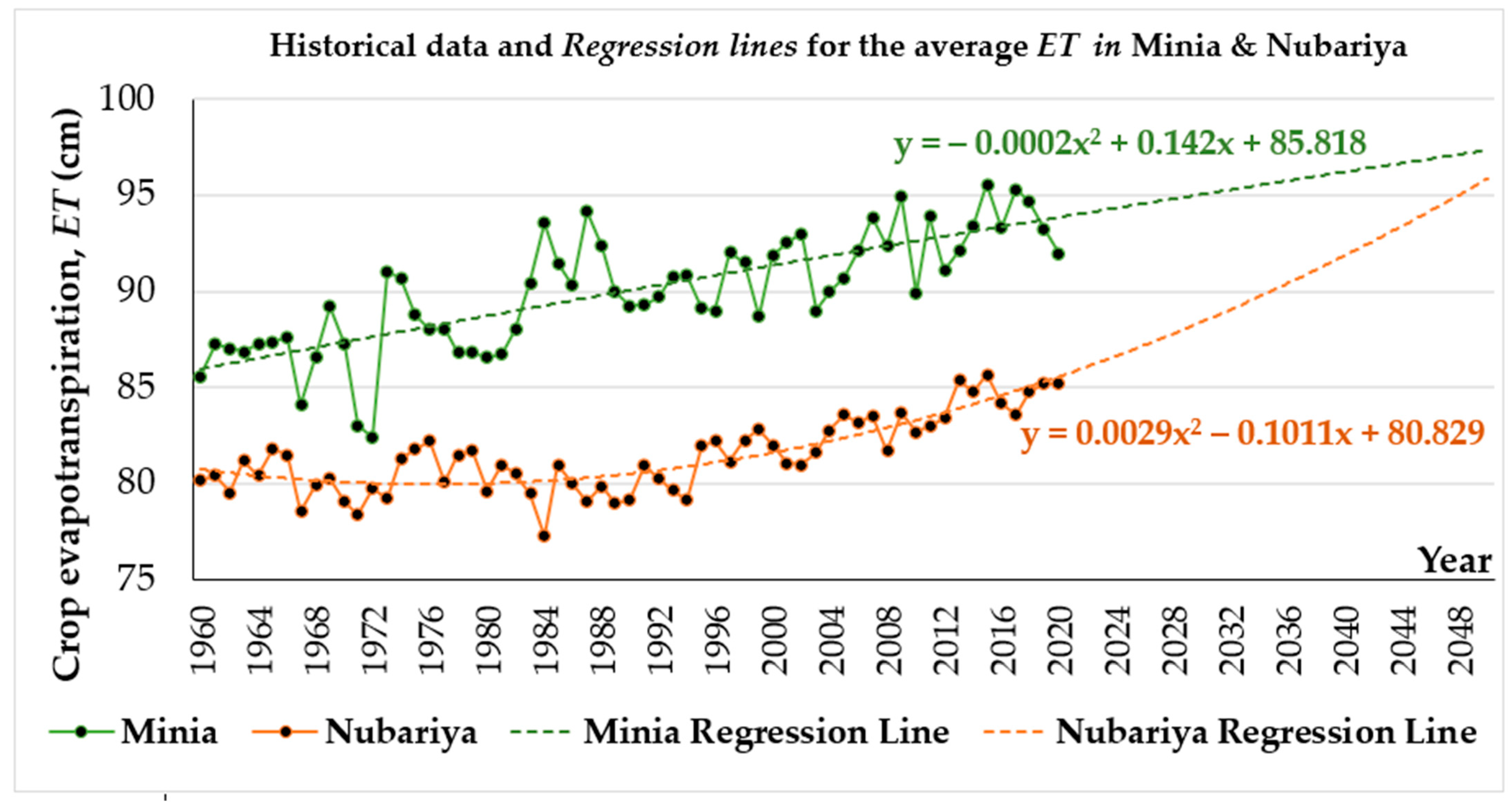The Water Evaluation and Planning System (WEAP) (
https://www.weap21.org/ (accessed on 24 April 2023)) was used for water resources modeling in Minia Governorate, central Egypt, on the western bank of the Nile Valley, and the Nubariya region, West Nile Delta, Egypt. The concept can be applied to similar urban water supply system patterns that might be anticipated in several cities across the nation, as well as on a worldwide scale. The Minia and Nubariya regions are struggling with dwindling hydrological supplies and rising seasonal water demands, particularly in the summer. Water resources must be properly quantified to create management strategies that are effective in addressing the issue of water scarcity. We attempt to quantify the geographically and temporally defined hydrological balance of the case studies geomorphology to evaluate the sustainability for actual water use.
WEAP models were set up, local main and branch canals were located, and surface flow calibration and validation were all part of the technique. The study’s use of surface flows and spring flows involved both measurement-based and estimation-based data, both of which were sourced from the Ministry of Water Resources and Irrigation (MWRI) (
https://www.mwri.gov.eg/ (accessed on 27 May 2023). Then, WEAP procedure cases were constructed, parameters had been calculated and examined in accordance with their bounds, compared to determine their effects, and lastly, we evaluated the best case that was the most like the observed flows with accepted parameter values. The model’s validations were then examined by contrasting the results from the models’ output at known streamflow gauge stations in the two study areas with those obtained from the streamflow simulations.
Figure 2 provides a description of the flowchart of used methodology.
The natural system components (rivers) and technical system components (reservoirs, diversions, canals, and cities) are schematized using a network of interconnected model elements with unprojected systems. Model elements are classified into two categories; demand nodes, user-defined supply options, demand priorities, and environmental requirements for each node are what drive the water management concept.
The database used was obtained by drawing the canal streams from Google Earth Pro and Landsat images [
30], besides the directories of various sectors, including the MWRI, Ministry of Agriculture (
https://moa.gov.eg/en (accessed on 20 April 2023), and Central Agency for Public Mobilization and Statistics (CAPMAS) (
https://www.capmas.gov.eg/HomePage.aspx (accessed on 25 February 2023). These data are gathered from surface water and groundwater in the study areas, rains, and reuse mixing stations from agriculture drains.
3.1. Data Collection
3.1.1. Water Resources and Demand in Minia
Al-Ibrahemia and Bahr Youssef canals (refer to
Figure 1) provide the area with water from Assiut Barrages on the Nile River. Due to the availability of information, 2020 was chosen as the base case. The model was fed by the Al-Ibrahemia Canal discharge value delivered to the study area while considering the minimum flow requirements that must be passed to the Beni-Souef region in the study area’s north (
Table 2). Groundwater reservoirs are a crucial tool for improving water-use efficiency. Since it was challenging to obtain the groundwater values for each month in the study area, we reduced the total discharge delivered to the study area by the groundwater’s total value for the year 2020 as provided by the CAPMAS. The study area also has five primary mixing pump stations for agricultural drainage (
Table 3).
Table 4 illustrates the monthly values for reusing water from drains through the five mixing stations.
Rain provides a secondary supply of water in the study area, but its scarcity and variability make it unreliable. The yearly rainfall in the area is expected to be 4 million m3 based on MWRI data. Due to the lack of this quantity and its irregularity, it was subtracted from the total water resource discharge in the area when data were entered into the model during months with reported rainfall events (December to March).
Agriculture is the primary water-consuming sector in the study area, accounting for more than 90% of the total available water resources. The farmed area is around 831,729 feddans and is irrigated by the Nile River and its branches (Ibrahemia and the Bahr Youssef canal). The area served in the model is 792,213 Feddans irrigated from the Ibrahemia and Bahr Youssef canals, as we did not consider the regions irrigated from the Nile in all computations in the study area. Domestic and industrial applications are considered for the second sector, utilizing water through 27 drinking stations (Posters), 7 from Ibrahemia consume about 10,250,368 m3/day, and 20 from Bahr Youssef consume about 37,154,372 m3/day.
3.1.2. Water Resources and Demand in Nubariya
The two main canals that supply the area from the Nile River in the west Nile Delta are the Mariot and Al-Nasr canals, which the Nubariya canal feeds through lifting station No. 3 because its bed rises uphill from Nubariya canal [
29]. We chose 2020 as the study base case based on the data availability for the study area; refer to
Figure 1.
Groundwater is an essential resource for reusing irrigation water that has leaked into the soil and hydrogeological layers to boost water efficiency. In the old lands, groundwater is the second most important source of irrigation after Nile water, and it is the primary source in the new lands and reclaimed desert. Groundwater is also a source of safe domestic water. However, in the Alexandria Governorate, rainwater is the second most important source of irrigation after the Nile, as there is no irrigation based on groundwater. The annual average rainfall in the Alexandria Governorate is around 0.12 billion m
3/year. It was challenging to obtain monthly groundwater and rainfall values in the study area. As a result, we collected their total values from CAPMAS Information for the year 2020 and deducted them from the total discharge given to the study region during the months when rainfall events were observed (December to March). In addition to one mixing pump station from the Al-Nasr-5 drain in the study area that is lifting the drain’s water to the Fara 8 aimen al-Banger branch canal through two pumps with a unit discharge of 1.0 m
3/s. The monthly values of water reuse discharge from drains through the mixing station (Mixing St. 18) are listed in (
Table 5).
Agriculture is the third economic sector in the Alexandria Governorate, behind industry and tourism, but it is the dominant economic sector in the Behera Governorate, employing approximately 43% of the Behera workforce. The Nile River and its branches irrigate 522,712 Feddans, the Mariot Canal irrigates 17,100 Feddans, and the Al–Nasr Canal irrigates 505,612 Feddans. In the Nubariya study area, the population is an important sector that consumes water through five drinking water purification stations: three from the Al–Nasr canal consume approximately 61,000 m3/day, one from the Al–Hamam canal consumes approximately 334,000 m3/day, and one from the Mariot canal consumes approximately 640,000 m3/day.
3.2. Set Up of WEAP Model to the Study Areas
Using ArcMap vol. 10.3, relevant datasets for the study areas were collected and organized in a geodatabase. GIS tools were used to process geospatial data. Hydrogeology, land use, water supply, agriculture demand, domestic and industrial consumption, mixing stations from drains, and management practices are among the organized data. WEAP was utilized to schematize the river network, canals, groundwater aquifers, and streams using GIS maps as a reference background. Water resources were classified into three categories: (1) dynamic bodies (such as surface water); (2) static bodies (such as groundwater and reservoir water); and (3) demand bodies (such as cities and agriculture). Following the identification of these forms, the allocation of water resources for the year 2020 was illustrated.
Minia schematization led to 29 demand nodes, 3 drainage reuse nodes, and 4 poster sites for domestic use, as shown in
Figure 3. Nodes for demand sites were added in each municipality dealing with livestock, domestic, industrial, and tourism water use.
To accommodate water exchanges between the environment and the water sectors, all nodes were linked with 39 transmission links and return elements. The rainfall modeling approach was based on MWRI data, which was subtracted from the overall water supply to the study area.
On the other hand, Nubariya schematization resulted in 25 demand nodes, 1 reuse node, and 3 poster sites for domestic use (
Figure 4). In each municipality, demand sites for livestock, household, industrial, and tourism water usage were added. To account for water transfers between the environment and the water sectors or across the various water sectors, all nodes were linked with 26 transmission and return elements. The rainfall volume in Nubariya was calculated using MWRI data and deducted from the research area’s total water supply.
WEAP achieves the principle of water balance for every link and node in the flow network according to demand priorities, supply preferences, mass balance, and other constraints. Mass balance equations are the WEAP foundation, where monthly water accounting: total inflows minus total outflows equals the net change in storage, if any.
Annual Demand in WEAP: The monthly demand represents the needed amount of water for the monthly site’s demand. A demand site (DS) for water is calculated as the sum of the demands for all demand sites through the smallest level branches [
25].
The annual demand is calculated according to crop patterns in the study areas obtained from CAPMAS, and the consumptive use for each crop depends on the Penman equation, where the seasonal or monthly consumptive water use (
Et) of a crop, in inches is [
31]:
where (
F) is the monthly water consumption factor, (
T) is the mean temperature through the month in Fahrenheit, and (
ρ) is the monthly percentage of daytime. The crop coefficient
is an empirical seasonal factor relating the seasonal plant water usage for a specific crop to the total seasonal consumptive use of water generated. To calculate
, the actual crop requirement of irrigation water must be measured during the growing season [
32,
33,
34],
can be calculated from measured
F and
Et. The share of each crop was calculated according to crop pattern consumptive use, and the cultivated area in the season. Then, monthly variation was calculated for each month in the study areas, as expressed in Equations (4) and (5).
where
is the share of consumptive use for each month during the year 2020,
is the consumptive use percent for each crop,
is the crop cultivated area (Feddans),
is the monthly variation percent, and
is the summation of total cultivated areas in the region during 2020 (in Feddans).
Monthly requirement from supply node: The supply requirement is the actual water amount that is needed from the supply sources. The supply requirement takes the demand and modifies it to account for internal reuse, demand site management strategies for reducing demand, and internal losses [
25,
35]. These three adjustment fractions are part of the input data in the model.
Transmission Links: Transmission links deliver water from supply nodes for final demand satisfaction at demand sites. In addition, they deliver drainage and wastewater outflows from demand sites for reuse [
36]. The amount delivered to the demand site equals the amount withdrawn from the source minus any losses. Losses indicate the evaporative loss and a percentage of the flow passing through a transmission link.
Referring to the WEAP model setup (
Figure 3 and
Figure 4 for the region schematics), flow requirements and demand sites were allocated water according to demand priorities. When there is a shortage of water, demand priorities are beneficial in illustrating the systems of water rights and in ensuring that higher priorities are met as completely as possible before smaller needs are considered [
17,
37]. In WEAP, the priority index ranges from 1 to 99, with the lower value representing higher priority and vice versa. Meanwhile, when priorities were the same, shortages were equally shared among all the demands.
3.3. Calibration Procedures
The complexity of water allocation models and the fact that they are required for human behavior simulation to reflect demand changes besides physical processes means that model calibration and validation are particularly challenging and have historically been disregarded [
35,
38,
39]. Calibration of a model refers to changing the values of the parameters so that the simulated results closely match the observed data [
40]. For the two models’ calibration, observed stream flow data were obtained from two gauging stations located on the main canals in the study areas, beside the main head flows to the areas. Calibration included changing the model parameters for better base-case simulation. WEAP21 has no routine for automatic calibration, so the changes implemented were tested by comparing the observed and simulated flows at the three observed points.
To calibrate the models, three calibration procedures were used to obtain the best case that satisfied the most acceptable parameters accuracy. The calibrated procedures are categorized by cases 1, 2, and 3.
Referring to
Figure 3, the two gauging sites in Minia are Sakoula Barrage at the end of the Bahr Youssef canal, and Maghagha Reservation at the end of Ibrahemia canal.
First, the model was performed in the base situation (case 1) using only the main head flow coming into the area from the Ibrahemia Canal (
Table S1 and Figure S1 in the Supplemental Materials). The model was then run with the observed discharge for the second gauge site from the chosen sites, Maghagha Reservation, which was obtained from MWRI. The results are shown in
Table S2 and Figure S2 in the Supplemental Materials as values for the simulated flows (case 2). The model was then run using the observed discharge for the third gauge site, Sakoula Barrage, and the results were obtained as stream flow values (case 3), as shown in
Table 6 and
Figure 5.
In each instance, model capabilities were investigated by comparing the simulated flow results with the actual flows in the area.
On the other hand, the two gauging sites in Nubariya are (1) station number 4 (St–4) and (2) station number 5 (St–5), as show in
Figure 4.
First, the model was performed in the base situation (case 1) using only the main head flow coming into the area from station number 3 on Al–Nasr Canal (St–3), as shown in
Table S1 and Figure S1 in the Supplementary Materials. The model was then run with the observed discharge for the second gauge site from the chosen sites, station number 4 (St–4), which was obtained from MWRI. The results are shown in
Table S4 and Figure S4 in the Supplemental Materials as values for the simulated flows (case 2). The model was then run using the observed discharge for the third gauge site, station number 5 (St– 5), and the results were obtained as stream flow values (case 3), as shown in
Table 7 and
Figure 6.
In each instance, model capabilities were investigated by comparing the simulated flow results with the actual flows in the area.
Two types of studies were performed for the model’s calibration: a comparison of the monthly and annual flows and a comparison of the flow frequencies. Physical observation serves as the basis for calibration [
41]. The comparison can be made for downstream stations where canal flows are calculated by simulation, with head flows directly entering the WEAP system. The method consists of a comparison (monthly or year-by-year) between the simulated and observed flows.
To evaluate the performance of the calibration results, the statistical parameters considered for this study were percent Bias (
PBIAS), Nash–Sutcliffe efficiency (
NSE), agreement index (
d), and volumetric efficiency (
VE), as expressed below [
26,
42,
43].
3.3.1. Percent Bias (PBIAS)
The average simulated data’s tendency to be greater or smaller than the corresponding real items is measured by percent bias (
PBIAS) [
26,
42,
43,
44]. Low
PBIAS levels signify accurate model simulation, and the ideal value is zero. Positive values indicate an underestimating bias in the model, whereas negative values indicate an overestimation bias in the model [
40,
43,
44]. PBIAS is calculated with Equation (8)
where
is the
ith value of the observed data,
is the
ith simulated value, and
is the total observations number.
3.3.2. Nash–Sutcliffe Efficiency (NSE)
The two main justifications for the suggestion of
NSE are that (1) ASCE, 1993 [
45,
46] recommends its use and (2) it provides a variety of information and frequently applies to described values. It should also be noticed that
NSE is the optimal objective function, reflecting the overall acceptance of a hydrograph [
47].
Nash–Sutcliffe efficiency (
NSE) is an indicator that is normalized to determine the relative magnitude of the residual variance compared to the observed data variance [
26,
43,
48,
49].
NSE reflects how well the plot of observed data compared to simulated data fits the 1:1 line.
NSE is computed as follows in Equation (9)
where
is the mean of the observed data.
NSE ranges between −∞ and 1.0, with
NSE = 1 being the ideal value. Values between 0.0 and 1.0 are generally viewed as acceptable performance levels, while values <0.0 indicate that the prediction of the mean observed value is better than the simulated value, which indicates an unacceptable level of performance [
26,
42,
49].
If
NSE has greater values, the better the model reproduces observations, with 1 being the ideal situation [
49,
50].
3.3.3. Agreement Index (d)
The degree of error for model prediction is uniformly measured by the index of agreement (
d) [
51] as a uniform measure of the degree of error for model prediction and varies between 0.0 and 1.0. Between the measured and simulated values, a computed value of 1 shows perfect agreement, while a calculated value of 0 indicates no agreement at all [
51,
52]. The agreement index signifies the potential error ratio and the mean square error [
53,
54]. The summation of the squared absolute values of the distances from the mean of measured observed values to the simulated values and the distances from observed values to the mean of observed values is used to quantify the potential error. The
can detect both relative and additive differences in the observed and simulated variances and means; however,
is too sensitive to extreme values due to the squared differences [
41,
46].
is computed as shown in Equation (10) as follows:
3.3.4. Volumetric Efficiency (VE):
According to [
26,
42,
49], generally, if
VE is 0 − 1, the model performance is satisfactory, with 1 being perfect agreement between observed and simulated values.
VE is calculated as shown in Equation (11):

